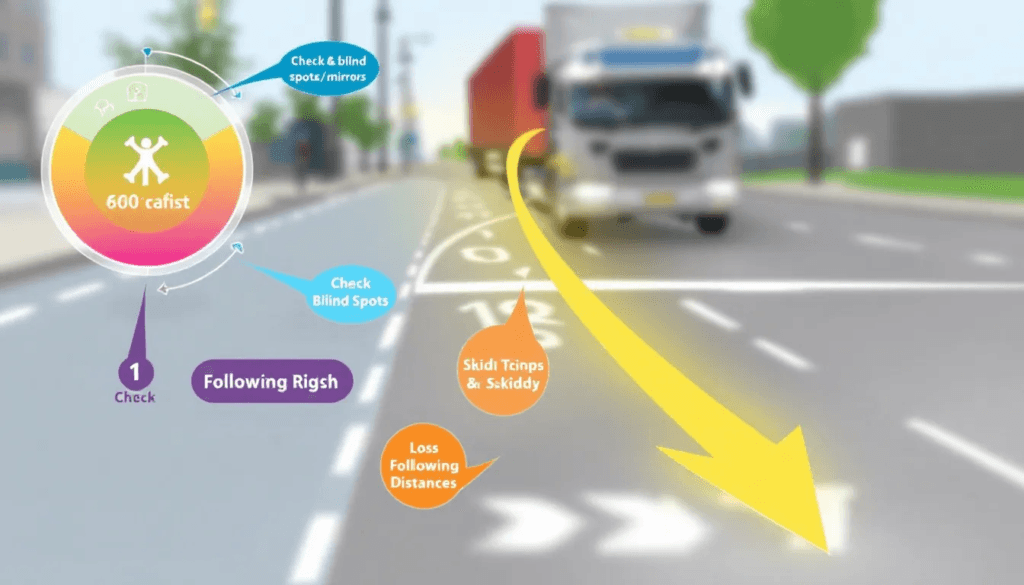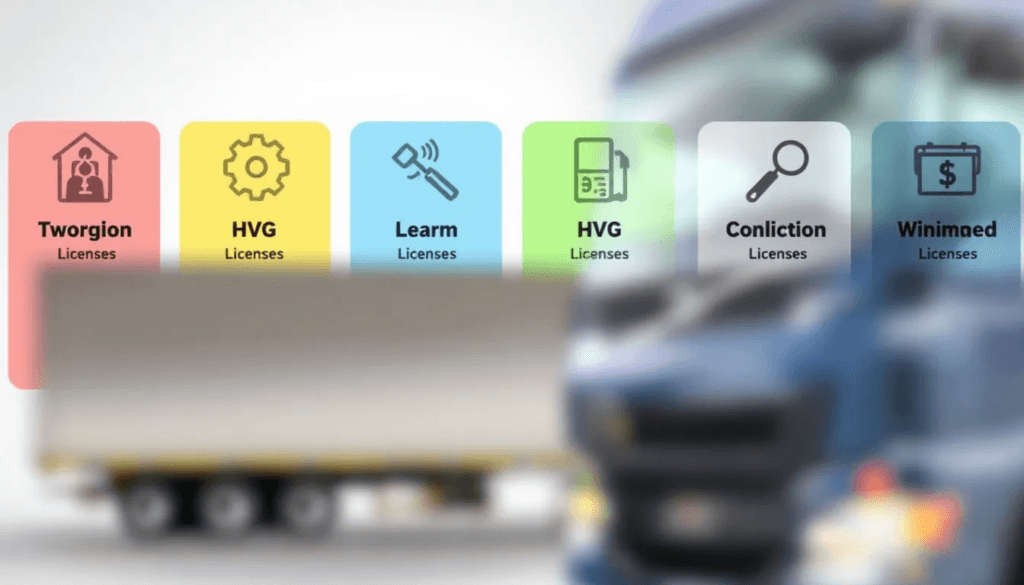Looking to learn HGV and start a driving career? This guide outlines the steps to get your HGV licence, types of licences, and essential training programs. Discover how you can become a professional HGV driver.
Key Takeaways
- Understanding HGV licences, including Cat C and C+E, is essential for aspiring drivers seeking career advancement in the industry.
- Choosing the right HGV training course, along with exploring financial options, is crucial for a successful transition into professional driving.
- Obtaining and maintaining Driver CPC certification, alongside additional skills and certifications, is necessary to ensure compliance and enhance employability in the HGV sector.
Understanding HGV Licences
The journey to becoming an HGV driver starts with understanding the different types of HGV licences. Heavy Goods Vehicle (HGV) licences are categorized based on the vehicle’s type and weight. The most common licences are the Category C (Cat C) and Category C+E (C+E) licences.
The Cat C licence allows you to drive vehicles over 3.5 tonnes but not exceeding 32 tonnes. These vehicles usually have a permanently attached cab and trailer, classifying them as rigid vehicles. This licence is ideal for those interested in local delivery jobs where maneuverability and control are crucial.
Aiming higher, the C+E licence allows you to drive articulated vehicles and tow trailers over 750kg. This is the highest level of HGV licence and opens up opportunities to operate larger, more complex vehicles, often used in long-haul transportation. Understanding these licences is the first step towards a rewarding HGV driving career.
Choosing the Right HGV Training Course
Choosing the right HGV training courses is crucial in ensuring you become a competent and confident driver. High-quality training programs are available for both novice and experienced drivers, catering to different needs and skill levels. These courses are designed to equip you with the skills necessary to operate heavy goods vehicles safely and efficiently.
Beginners typically undergo practical training structured as 3-hour sessions over 5 or 8 consecutive days. Experienced drivers looking to upgrade to a CE/Class 1 licence might consider a 10-day course, provided they have appropriate experience with LGV C / HGV Class 2 vehicles. The cost of such courses can vary, with a 9-day CE/Class 1 course priced at £3,245.00, while a 4-day Class 2 licence course costs £1,545.00.

Moreover, private driving schools across the UK offer tailored training programs, and career advice is available to help you choose the right course. The right training will put you on the path to obtaining your HGV licence and starting your professional driving career.
The Importance of Driver CPC Certification
Driver CPC (Certificate of Professional Competence) certification is mandatory for anyone who drives HGVs, buses, or coaches professionally. This certification ensures that drivers meet high standards of road safety and legal compliance. The Initial Driver CPC comprises two tests that must be passed to receive the driver certificate, a crucial step in your professional driving journey.
Complete 35 hours of periodic training every five years to keep your Driver CPC certification. Failing to do so can result in significant fines, up to £1,000, and could prevent you from driving professionally. Regular training not only keeps you compliant but also enhances your skills, ensuring you remain a safe and competent driver on the road.
Steps to Obtain Your HGV Licence
Obtaining your HGV licence involves several key steps. First, you need to apply for a provisional hgv license by filling out forms D2 and D4, which specify the vehicle category you aim to drive. If you have a paper driving licence, include a passport-style photo and valid identification with your application.
A medical examination is required to ensure you meet the health standards for driving an HGV. The D4 form, completed by a doctor, assesses your health conditions relevant to driving. Once the DVLA receives your provisional licence application, it typically takes about three weeks to process.
After receiving your provisional licence, you can begin your HGV training. Completing your training prepares you for the final step – passing the driving test. Following these steps will set you on the path to becoming a professional HGV driver.
Finance Options for HGV Training
Financing your HGV training can be a significant concern, but various financial aid options are available to help manage the costs. Government-funded Skills Bootcamps offer free training lasting up to 16 weeks for aspiring HGV drivers. These programs provide essential support, allowing you to focus on your training without the immediate financial burden.
Private financing options are also available, such as the ‘Train Now Pay Later’ schemes, which let you start your training without upfront full payment. Snap Finance collaborates with training providers to offer accessible financial options, even for individuals with previous credit issues. With a minimal initial deposit of just 1%, you can choose repayment plans extending from 12 to 48 months.

These finance options make it easier to manage the costs of HGV training, ensuring you can pursue your career goals without financial stress. Exploring these opportunities will help you find a plan that fits your budget, allowing you to start your journey to becoming an HGV driver.
Benefits of Becoming an HGV Driver
Becoming an HGV driver comes with numerous benefits, making it an attractive career choice. One of the most significant advantages is job security. HGV drivers play a crucial role in the economy, ensuring goods are transported efficiently across various sectors. The current shortage of drivers in the UK has led to increased wages and a variety of job opportunities.
HGV drivers can earn a substantial income, with starting salaries around £32,000 annually, and with experience, salaries can reach up to £50,000. Additionally, there are numerous advancement opportunities, including promotions to managerial roles or specialized transport positions.
The profession also offers a level of independence, allowing drivers to manage their schedules and make decisions on the job. Moreover, it provides a range of new experiences, enabling drivers to travel and meet diverse individuals. These benefits make a career as an HGV driver both rewarding and fulfilling.
Additional Skills and Certifications
In addition to your HGV licence, obtaining additional skills and certifications can enhance your qualifications and employability. ADR training, for instance, is required to transport hazardous goods by road. This certification covers regulations and safety measures, ensuring you can safely handle and transport hazardous materials.
Extra certifications make you a more versatile and valuable driver, opening up more job opportunities and potentially higher earnings. Continually improving your skills and knowledge will keep you well-prepared and confident in your professional driving career.
Tips for Passing Your HGV Driving Test
Passing your HGV driving test is a significant milestone in your journey to becoming a professional driver. Practice is crucial, especially for challenging reversing and parking maneuvers. The more you practice, the more confident you will feel on test day.
Ensure you get adequate rest the night before the test and maintain a balanced diet to enhance your focus and performance. Arriving at least 15 minutes early and having all necessary documents ready can help reduce pre-test stress. The practical test lasts 1 hour and 30 minutes and includes vehicle safety questions, road driving, and off-road exercises.
You can make up to 15 minor errors without failing, but only one major error is allowed. During the test, check your mirrors every 5-10 seconds to demonstrate awareness to the examiner. Following these tips will prepare you well for passing your HGV driving test and obtaining your licence.

Job Opportunities for Qualified HGV Drivers
Before:
Once you have your HGV licence, a world of job opportunities awaits. Some of the main employers of HGV drivers include delivery companies and logistics firms. Additionally, construction companies also employ these drivers. Retail companies also hire HGV drivers to maintain stock levels in their stores, indicating a steady demand.
After:
Some of the main employers of HGV drivers include:
- Delivery companies
- Logistics firms
- Construction companies
- Retail companies
Once you have your HGV licence, a world of job opportunities awaits, indicating a steady demand for drivers.
In the food and beverage sector, HGV drivers are tasked with delivering perishable goods on tight schedules. Waste management companies employ HGV drivers for transporting and managing waste materials. The construction industry relies heavily on HGV drivers to transport building materials to sites.
HGV drivers play a crucial role in logistics, ensuring goods are delivered efficiently across various sectors. This profession not only offers the freedom to travel and experience different places but also provides a sense of pride in delivering essential goods and contributing to society.
Maintaining Your HGV Licence and CPC
Maintaining your HGV licence and Driver CPC is essential to continue driving professionally. Complete 35 hours of periodic training every five years to keep your Driver CPC up to date. This training ensures compliance with safety standards and legal requirements.
Additionally, some certifications, like HIAB, require refresher training every five years to maintain validity. Regular training not only keeps your certifications current but also enhances your skills, making you a more competent and safer driver on the road.

Summary
In summary, starting a career as an HGV driver involves understanding various licences, choosing the right training course, obtaining Driver CPC certification, and navigating the steps to get your licence. With numerous financial aid options and the benefits of job security, high earnings, and independence, becoming an HGV driver is a fulfilling career choice.
By gaining additional skills and certifications, you can enhance your employability and job opportunities. With the right preparation and ongoing training, you’ll be well-equipped to succeed in this rewarding profession. Now is the time to take the wheel and start your journey as an HGV driver.
Frequently Asked Questions
What are the different types of HGV licences?
The main types of HGV licences are the Category C licence for vehicles over 3.5 tonnes and the Category C+E licence for articulated vehicles and trailers over 750kg. Each licence serves specific vehicle requirements essential for professional drivers.
How long does it take to obtain an HGV licence?
Obtaining an HGV licence typically takes several weeks to a few months, depending on training and testing schedules. It’s important to plan accordingly to streamline the process.
What is the cost of HGV training courses?
HGV training courses typically range from £1,545.00 for a 4-day Class 2 licence course to £3,245.00 for a 9-day CE/Class 1 course. It’s essential to consider the specific course length and type when budgeting for training.
What is Driver CPC certification, and why is it important?
Driver CPC certification is essential for professional HGV drivers as it ensures road safety and legal compliance through required tests and ongoing training. This certification not only enhances driver skills but also promotes safer driving practices on the roads.
What job opportunities are available for qualified HGV drivers?
Qualified HGV drivers have various job opportunities in delivery companies, logistics firms, construction, retail, food and beverage sectors, and waste management. These sectors consistently seek skilled drivers to meet their transportation needs.



